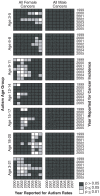The correlation between rates of cancer and autism: an exploratory ecological investigation
- PMID: 20186340
- PMCID: PMC2826417
- DOI: 10.1371/journal.pone.0009372
The correlation between rates of cancer and autism: an exploratory ecological investigation
Abstract
Background: Autism is associated with high rates of genomic aberrations, including chromosomal rearrangements and de novo copy-number variations. These observations are reminiscent of cancer, a disease where genomic rearrangements also play a role. We undertook a correlative epidemiological study to explore the possibility that shared risk factors might exist for autism and specific types of cancer.
Methodology/principal findings: To determine if significant correlations exist between the prevalence of autism and the incidence of cancer, we obtained and analyzed state-wide data reported by age and gender throughout the United States. Autism data were obtained from the U.S. Department of Education via the Individuals with Disabilities Education Act (IDEA) (2000-2007, reported annually by age group) and cancer incidence data were obtained from the Centers for Disease Control and Prevention (CDC) (1999-2005). IDEA data were further subdivided depending on the method used to diagnose autism (DSM IV or the Code of Federal Regulations, using strict or expanded criteria). Spearman rank correlations were calculated for all possible pairwise combinations of annual autism rates and the incidence of specific cancers. Following this, Bonferroni's correction was applied to significance values. Two independent methods for determining an overall combined p-value based on dependent correlations were obtained for each set of calculations. High correlations were found between autism rates and the incidence of in situ breast cancer (p < or = 10(-10), modified inverse chi square, n = 16) using data from states that adhere strictly to the Code of Federal Regulations for diagnosing autism. By contrast, few significant correlations were observed between autism prevalence and the incidence of 23 other female and 22 male cancers.
Conclusions: These findings suggest that there may be an association between autism and specific forms of cancer.
Conflict of interest statement
Figures


Similar articles
-
A comparison of temporal trends in United States autism prevalence to trends in suspected environmental factors.Environ Health. 2014 Sep 5;13:73. doi: 10.1186/1476-069X-13-73. Environ Health. 2014. PMID: 25189402 Free PMC article.
-
Prevalence of Autism Spectrum Disorder Among Children Aged 8 Years - Autism and Developmental Disabilities Monitoring Network, 11 Sites, United States, 2014.MMWR Surveill Summ. 2018 Apr 27;67(6):1-23. doi: 10.15585/mmwr.ss6706a1. MMWR Surveill Summ. 2018. PMID: 29701730 Free PMC article.
-
Comorbidity of intellectual disability confounds ascertainment of autism: implications for genetic diagnosis.Am J Med Genet B Neuropsychiatr Genet. 2015 Oct;168(7):600-8. doi: 10.1002/ajmg.b.32338. Epub 2015 Jul 22. Am J Med Genet B Neuropsychiatr Genet. 2015. PMID: 26198689
-
What's going on? The question of time trends in autism.Public Health Rep. 2004 Nov-Dec;119(6):536-51. doi: 10.1016/j.phr.2004.09.003. Public Health Rep. 2004. PMID: 15504445 Free PMC article. Review.
-
Annual report to the nation on the status of cancer, 1975-2000, featuring the uses of surveillance data for cancer prevention and control.J Natl Cancer Inst. 2003 Sep 3;95(17):1276-99. doi: 10.1093/jnci/djg040. J Natl Cancer Inst. 2003. PMID: 12953083 Review.
Cited by
-
Neurodevelopmental disorders and cancer networks share pathways, but differ in mechanisms, signaling strength, and outcome.NPJ Genom Med. 2023 Nov 4;8(1):37. doi: 10.1038/s41525-023-00377-6. NPJ Genom Med. 2023. PMID: 37925498 Free PMC article.
-
The impact of the metabotropic glutamate receptor and other gene family interaction networks on autism.Nat Commun. 2014 Jun 13;5:4074. doi: 10.1038/ncomms5074. Nat Commun. 2014. PMID: 24927284 Free PMC article.
-
A review of the role of female gender in autism spectrum disorders.J Autism Dev Disord. 2013 Nov;43(11):2584-603. doi: 10.1007/s10803-013-1811-1. J Autism Dev Disord. 2013. PMID: 23525974 Review.
-
Social Contacts and Transmission of COVID-19 in British Columbia, Canada.Front Public Health. 2022 May 3;10:867425. doi: 10.3389/fpubh.2022.867425. eCollection 2022. Front Public Health. 2022. PMID: 35592086 Free PMC article.
-
Medical symptoms and conditions in autistic women.Autism. 2022 Feb;26(2):373-388. doi: 10.1177/13623613211022091. Epub 2021 Jun 29. Autism. 2022. PMID: 34184558 Free PMC article.
References
-
- Vorstman JA, Staal WG, van Daalen E, van Engeland H, Hochstenbach PF, et al. Identification of novel autism candidate regions through analysis of reported cytogenetic abnormalities associated with autism. Mol Psychiatry. 2006;11:1, 18–28. - PubMed
Publication types
MeSH terms
Grants and funding
LinkOut - more resources
Full Text Sources

